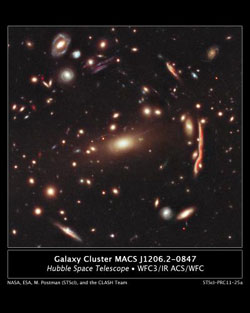

The distorted shapes in the cluster are distant galaxies from which the light is bent by the gravitational pull of an invisible material called dark matter within the cluster of galaxies. This cluster is an early target in a survey that will allow astronomers to construct the most detailed dark matter maps of more galaxy clusters than ever before.
These maps are being used to test previous, but surprising, results that suggest that dark matter is more densely packed inside clusters than some models predict. This might mean that galaxy cluster assembly began earlier than commonly thought.
The multi-wavelength survey, called the Cluster Lensing And Supernova survey with Hubble (CLASH), probes, with unparalleled precision, the distribution of dark matter in 25 massive clusters of galaxies. So far, the CLASH team has observed six of the 25 clusters.
Dark matter makes up the bulk of the universe's mass, yet it can only be detected by measuring how its gravity tugs on visible matter and warps space like a fun house mirror so that the light from distant objects is distorted.
Galaxy clusters like MACS 1206 are perfect laboratories for studying dark matter's gravitational effects because they are the most massive structures in the universe. Because of their heft, the clusters act like giant cosmic lenses, magnifying, distorting and bending any light that passes through them – an effect known as gravitational lensing.
Lensing effects can also produce multiple images of the same distant object, as evident in this Hubble picture. In particular, the apparent numbers and shapes of distant galaxies far beyond a galaxy cluster become distorted as the light passes through, yielding a visible measurement of how much mass is in the intervening cluster, and how it is distributed. The substantial lensing distortions seen are proof that the dominant component of clusters is dark matter. The distortions would be far weaker if the clusters' gravity came only from the visible galaxies in the clusters.
MACS 1206 lies 4 billion light-years from Earth. Hubble's keen vision helped CLASH astronomers uncover 47 multiple images of 12 newly identified faraway galaxies. Finding so many multiple images in a cluster is a unique capability of Hubble, and the CLASH survey is optimized to find them. The new observations build on earlier work by Hubble and ground-based telescopes.
Taking advantage of two of Hubble's powerful cameras, the Advanced Camera for Surveys and the Wide Field Camera 3, the CLASH survey covers a broad wavelength range, from ultraviolet to near infrared. Astronomers need the diverse colors to estimate the distances to lensed galaxies and study them in more detail. Hubble's unique capabilities allow astronomers to estimate distances to galaxies that are four times fainter than ground-based telescopes can see.
The era when the first clusters formed is not precisely known, but is estimated to be at least 9 billion years ago and possibly as far back as 12 billion years ago. If most of the clusters in the CLASH survey are found to have excessively high accumulations of dark matter in their central cores, then it may yield new clues to the early stages in the origin of structure in the universe.
Future telescopes like NASA's James Webb Space Telescope, a space-based infrared observatory now being built, will be able to study the fainter lensed galaxies in clusters like MACS 1206 in greater detail. The Webb will be powerful enough to the spectra of some of the magnified galaxies to study their early chemical composition.
The Hubble Space Telescope is a project of international cooperation between NASA and the European Space Agency. NASA's Goddard Space Flight Center manages the telescope. The Space Telescope Science Institute (STScI) conducts Hubble science operations. STScI is operated for NASA by the Association of Universities for Research in Astronomy, Inc., in Washington, D.C.












